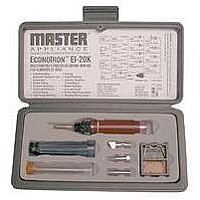CDB4338 Cirrus Logic Inc, CDB4338 Datasheet - Page 2

CDB4338
Manufacturer Part Number
CDB4338
Description
Development Kit
Manufacturer
Cirrus Logic Inc
Datasheet
1.CDB4334.pdf
(14 pages)
Specifications of CDB4338
Silicon Manufacturer
Cirrus Logic
Application Sub Type
DAC
Kit Application Type
Data Converter
Silicon Core Number
CS4338
Description/function
Audio D/A
Operating Supply Voltage
5 V
Product
Audio Modules
Kit Contents
Evaluation Board
Rohs Compliant
No
Lead Free Status / RoHS Status
Contains lead / RoHS non-compliant
For Use With/related Products
CS4338
CDB4334/8/9 SYSTEM OVERVIEW
The CDB4334/8/9 evaluation board is an excellent
means of quickly evaluating the CS4334/8/9. The
CS8414 digital audio interface receiver provides an
easy interface to digital audio signal sources in-
cluding the majority of digital audio test equip-
ment. The evaluation board also allows the user to
supply clocks and data through a 10-pin header for
system development.
The CDB4334/8/9 schematic has been partitioned
into 7 schematics shown in Figures 2 through 8.
Each partitioned schematic is represented in the
system diagram shown in Figure 1. Notice that the
the system diagram also includes the interconnec-
tions between the partitioned schematics.
The CS8414 does not support a compatible data
format for the CS4335, CS4336 or CS4337. As a
result, an evaluation board is not available for these
devices. However, the evaluation board does allow
external generation of clocks and data, bypassing
the CS8414, and will support the CS4335/36/37 in
this configuration.
CS4334/8/9 DIGITAL TO ANALOG
CONVERTER
A description of the CS4334/5/6/7/8/9 is included
in the CS4334/5/6/7/8/9 data sheet.
CS8414 DIGITAL AUDIO RECEIVER
The system receives and decodes the standard
S/PDIF data format using a CS8414 Digital Audio
Receiver, Figure 5. The outputs of the CS8414 in-
clude a serial bit clock, serial data, left-right clock
(FSYNC), de-emphasis control and a 256 Fs mas-
ter clock. The operation of the CS8414 and a dis-
cussion of the digital audio interface are included in
the CS8414 Datasheet.
During normal operation, the CS8414 operates in
the Channel Status mode where the LED’s display
channel status information for the channel selected
24
by the CSLR/FCK jumper. This allows the CS8414
to decode the de-emphasis bit from the digital au-
dio interface for control of the CS4334/8/9 de-em-
phasis filter.
When the Error Information Switch is activated,
the CS8414 operates in the Error and Frequency in-
formation mode. The information displayed by the
LED’s can be decoded by consulting the CS8414
data sheet. It is likely that the de-emphasis control
for the CS4334/8/9 will be erroneous and produce
an incorrect audio output if the Error Information
Switch is activated and the CS4334/8/9 is in the in-
ternal serial clock mode.
Encoded sample frequency information can be dis-
played provided a proper clock is being applied to
the FCK pin of the CS8414. When an LED is lit,
this indicates a "1" on the corresponding pin locat-
ed on the CS8414. When an LED is off, this indi-
cates a "0" on the corresponding pin. Neither the L
or R option of CSLR/FCK should be selected if the
FCK pin is being driven by a clock signal.
The evaluation board has been designed such that
the input can be either optical or coax, Figure 6.
However, both inputs can not be driven simulta-
neously.
CS8414 DATA FORMAT
The CS8414 data format can be set with jumpers
M0, M1, M2, and M3, as described the CS8414
datasheet. The format selected must be compatible
with the data format of the CS4334/8/9, shown in
Figures 4-7 of the CS4334/8/9 datasheet. The de-
fault settings for M0-M3 on the evaluation board
are given in Tables 2-4. The compatible data for-
mats we have chosen for the CS8414 and
CS4334/8/9 are:
CS8414 format 2 ; CS4334
CS8414 format 5 ; CS4338
CS8414 format 6 ; CS4339
CDB4334/8/9
DS248DB2


















